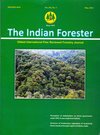Economic Losses Due to Forest Fire as a Climate Change Incidences in Sidhababa Community Forest of Bara District, Nepal
DOI:
https://doi.org/10.36808/if/2016/v142i5/95044Keywords:
Climate Change, Forest Fire, Carbon Emission, Sequestration of CO2 Economic Valuation.Abstract
Climate change is major concern of the world due to global warming. It plays vital role to increase forest fire incidences and causes huge economic losses and human death. Fire-induces loss of soil cover negatively affects hydrological regimes and soil properties. Therefore the research was conducted on this topic. The field work approaches included forest inventory and contingent valuation. Similarly laboratory test, secondary data and formulae assumed to conclude the result of carbon emission and loss in sequestration and their economic values. The economic loss due to burning of timber, leaf litter, fuel wood of the forest and emission of CO2 due the burning of leaf litter, timber and fuel wood was estimated as IRs. 96686.04per hector per annum in the community forest. Sequestration losses were not found in the forest because there was no damage caused in standing trees during the surface forest fire. The most devastating crown forest fire was not recorded in the forest. But small shoots of the regeneration and NTFPs was found to be damaged. On return of favorable condition most of the regenerations and NTFPs again come up but very small and intolerable seedlings was seen as completely damaged due to forest fire.References
Acharya K.P. and Sharma S.P. (2009). Present Status, Legal Provisions and Practical Problems on Wild land Fire Management in Nepal, Paper presented in a national workshop on Development of a National Strategy for Wild land Fire Management in Nepal 22 June Kathmandu.
Bahuguna V.K. and Singh S. (2002). Fire situation in India. Int. Forest Fire News No. 26
Banerjee A. and Chowdhury M. (2013). Forest degradation and livelihood of local communities in India: A human rights approach. J. Horticulture and Forestry, 5(8):122-129, September, 2013 DOI 10.5897/JHF2013.0305
BISEP-ST/ Technical paper (2007). Basic statistical report 2062, BISEP-ST Hetauda unit, Ministry of Forest and Soil Conservation, Government of Nepal. Pp. 47-59.
CRED (2007). “Annual Disaster Statistical Reviewâ€, The Number and Trends 2007, Centre for Research on the Epidemiology of Disasters (CRED), www.cred.be
DoF (2005). “Forest Cover Change Analysis of the Terai Districtsâ€, Department of Forest, Kathmandu, Nepal
DSCWM (2010). “National Seminar on Churia Region Environmenal Study Proceedingsâ€, Department of Soil Conservation and Watershed Management, Babarmahal Kathmandu
ICIMOD (2007). Disaster Preparedness for Natural Hazards, Current Status in Nepal, International Center for Integrated Mountain Development (ICIMOD), Kathmandu, Nepal
IFFN (2005) “The Impact of Forest Fire Damages ont he Total Economic Value of Forest Resource sin Turkey†International Forest Fire News (IFFN) No. 33 (July– Dec.2005, 88-92) ISSN 1029-0864
Kodandapani N. (2013). Contrasting Fire Regimes in A Seasonally Dry Tropical Forest and A Savanna Ecosystem in The Western Ghats. India Fire Ecology, 9(2):102
MoFSC (2006). “Nepal National Strategy for ChuriaProgrammeâ€, Ministry of Forest and Soil Conservation, Singha Durbar, Kathmandu, Nepal
Murthy M.S.R., Badarinath K.V.S., Biswadip Gharai, Rajshekhar G. and Roy P.S. (2006). “The Indian Forest Fire Response and Assessment System†International Forest Fire News (IFFN) No. 34 (January – June 2006, 72-77) ISSN 1029-0864
NCVST (Nepal climate vulnerability study team) 2009. “Vulnerability through the eyes of the vulnerable†climate change induced uncertainties and Nepal’s development predicaments published by institute for social and environmental transition-Nepal
NWPC (2014), (National Working Plan Code – 2014) “For Sustainable Management of Forests and Biodiversity in India†Forest Research Institute, Dehradun, ICFRE, Ministry of Environment & Forests, Government of India
ODF, (2013). “2013: An epic fire season in Oregon†Oregon Department of Forestry. 503.945.7200, www.oregon.gov/odf
Ramanathan V., Ramana M., Roberts G., Kim D., Corrigan C., Chung C. and Winker D. (2007). Warming trends in Asia amplified by brown cloud solar absorption. Nature, Vol. 448, 2 August, 2007.
Ray G. (2002). “Forest Protection and Development: District Forest Office, Dhanushaâ€, Janakpur
Satendra and Kaushik A.D. (2012). “FOREST FIRE DISASTER MANAGEMENTâ€National Institute of Disaster Management, Ministry of Home Affairs, Govt. of India IIPA Campus, 5B I.P. Estate, Ring Road New Delhi-110002
Sharma S.P. (2006). “Participatory Forest Fire Management: An Approach†published in International Forest Fire News (IFFN) No. 34 ISSN 1029-0864 NEPAL
Downloads
Downloads
Published
How to Cite
Issue
Section
License
Unless otherwise stated, copyright or similar rights in all materials presented on the site, including graphical images, are owned by Indian Forester.





